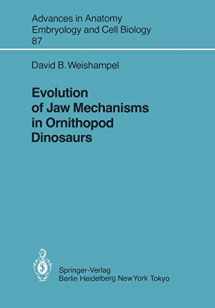
Evolution of Jaw Mechanisms in Ornithopod Dinosaurs (Advances in Anatomy, Embryology and Cell Biology, 87)
ISBN-13:
9783540131144
ISBN-10:
3540131140
Edition:
Softcover reprint of the original 1st ed. 1984
Author:
David B. Weishampel
Publication date:
1984
Publisher:
Springer
Format:
Paperback
120 pages
FREE US shipping
Book details
ISBN-13:
9783540131144
ISBN-10:
3540131140
Edition:
Softcover reprint of the original 1st ed. 1984
Author:
David B. Weishampel
Publication date:
1984
Publisher:
Springer
Format:
Paperback
120 pages
Summary
Evolution of Jaw Mechanisms in Ornithopod Dinosaurs (Advances in Anatomy, Embryology and Cell Biology, 87) (ISBN-13: 9783540131144 and ISBN-10: 3540131140), written by authors
David B. Weishampel, was published by Springer in 1984.
With an overall rating of 3.6 stars, it's a notable title among other
books. You can easily purchase or rent Evolution of Jaw Mechanisms in Ornithopod Dinosaurs (Advances in Anatomy, Embryology and Cell Biology, 87) (Paperback) from BooksRun,
along with many other new and used
books
and textbooks.
And, if you're looking to sell your copy, our current buyback offer is $0.48.
Description
The Ornithopoda, one of five suborders within the Ornithischia, was originally proposed by Marsh in 1881 to include those bipedal dinosaurs possessing a predentary bone fitted over the rostral end of the mandibles. Ornithopods as recognized today can be further characterized by moderately long facial skele tons equipped with well-developed, often toothless premaxillae and moderate to large external nares. Maxillary and dentary dentitions vary but usually consist of at least one replacement series beneath the functional set; some have many rows of successional teeth. Tooth morphology suggests ornithopods were suc cessful herbivores but, as will be discussed, the precise way(s) in which ornitho pods chewed their food, hence lending important information about their tro phic position, has not been settled. Postcranially, ornithopods show specializa tion for bipedality in hindlimb construction and lack well-developed protective structures on their flanks, back, and tail. The Ornithopoda can itself be divided into five families: Fabrosauridae, He terodontosauridae, Hypsilophodontidae, 19uanodontidae, and Hadrosauridae (subdivided into the subfamilies Hadrosaurinae and Lambeosaurinae). Both fabrosaurids and heterodontosaurids, first known from the Late Triassic and Early Jurassic of Argentina and South Africa, were small animals differing in details of cranial, dental, and appendicular anatomy. Fabrosaurids are be lieved to represent the basal ornithopod stock (Galton 1972, 1978; Thulborn 1970a, 1972). During the Jurassic, ornithopods underwent major radiations that included the medium- to large-sized Hypsilophodontidae and the large bodied Iguanodontidae, both of which survived into the Cretaceous.


We would LOVE it if you could help us and other readers by reviewing the book
Book review

Congratulations! We have received your book review.
{user}
{createdAt}
by {truncated_author}


